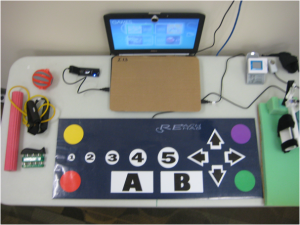Rehabilitative Therapy & Stem Cells? What’s the Connection?
Posted on November 3, 2014
Stroke can be a very debilitating condition and patients who have been affected show better results from recovery if they are given access to higher intensity, greater duration rehabilitative therapy. However, our current practices for rehabilitation are limited for many patients due to various reasons such as cost or access. Over in the Cramer lab, we conduct research in stroke rehabilitation and neuroimaging to explore emerging therapies, improve brain repair and reduce disability. Currently the lab is focusing research efforts on trying to make stroke recovery an easier and more cost effective solution. Patients are able to use a computerized gaming system at home to practice their therapy and exercises.
Patients are able to use a computerized gaming system at home to practice their therapy and exercises. Patients are able to use a computerized gaming system at home to practice their therapy and exercises.
Patients are able to use a computerized gaming system at home to practice their therapy and exercises.
Therapists were able to adjust game and exercise settings such as level of difficulty to provide just enough challenge to keep patients motivated and engaged. Just as scientific techniques and technology evolve, our lab evolves and advances as well. In a day and age where people are only a button click away and computers are getting more powerful and more portable, we are striving to adapt this technology to new medical rehabilitation practices to improve arm and hand function. One of our major projects utilized some of the currently available technology, adapting it for use in a telerehabilitation system. Patients were able to use a computerized gaming system, set up in their home, to practice their therapy and exercises. Patients were contacted during their home therapy via videoconference calls to evaluate progress and discuss issues. Therapists were able to adjust game and exercise settings such as level of difficulty to provide just enough challenge to keep patients motivated and engaged.
Turning traditional therapy into virtual reality games familiar to people, such as simon says, duck hunt, black jack and poker, provided patients with an enjoyable and fun experience and provided an amazing compliance rate of 97.9% in our pilot study. Patients also made significant gains in arm and hand function on scales used to test for disability post-stroke. We are now evolving our telerehabilitation studies even further by expanding our original computer system with new games and commercially available USB devices repurposed for therapy. This exciting new multi-site study will allow us to expand our discoveries providing the opportunity to bring telerehabilitation into the homes of patients across the nation. We are currently in the planning stages of this project but enrollment will soon be open across multiple sites across the country.
Now you may be wondering how we fit into a stem cell facility if we are focusing on rehabilitation and not on stem cell research. We believe that in order for stem cell therapy to be effective in people, they need an outlet to retrain what was lost. Finding the best techniques for rehab and seeing significant results in patients without stem cell therapy can only be furthered when stem cell therapy advances and becomes a more commonplace practice. These types of rehabilitation programs can only boost the effectiveness of stem cell therapies and provide maximum impact and the best outcomes for our patients. As science and technology advance we can only imagine how they’ll be adapted to better humankind.
